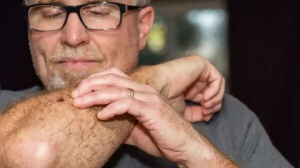Osteoporosis, often called the “silent disease,” weakens bones, making them fragile and prone to fractures from minor falls or everyday movements. It occurs when bone density decreases, increasing the risk of breaks in areas like the hip, wrist, and spine, and affects millions in the UK, particularly those over 50, with women at greater risk post-menopause.
According to a study published in StatPearls, osteoporosis is defined as low bone mineral density caused by altered bone microstructure, predisposing patients to low-impact, fragility fractures. The condition often progresses silently, so early diagnosis and management through medication, calcium and vitamin D intake, weight-bearing exercise, and lifestyle changes are essential.
Understanding osteoporosis and how it weakens hips, wrists, and spine
Osteoporosis is a bone disease that reduces bone density and strength, making bones fragile. Healthy bones are dense and strong enough to support your weight and absorb impact. However, with osteoporosis, bones become thin and porous, increasing the risk of fractures.
The condition commonly affects:
Hips (hip fractures)
Wrists
Spine (vertebral fractures)
Over time, bone loss happens naturally as we age, but osteoporosis accelerates this process. In fact, most people are unaware they have osteoporosis until they experience a fracture.
How common is osteoporosis
- Over 50 million people in the United States have osteoporosis.
- In the UK, it is estimated that 1 in 2 women and 1 in 5 men over 50 will break a bone due to osteoporosis.
Osteopenia, a condition where bone density is lower than normal, affects many adults over 50 and can progress to osteoporosis if left untreated.
Symptoms of osteoporosis
Osteoporosis usually does not cause obvious symptoms in its early stages. This is why it’s often referred to as a silent disease. However, as bones weaken, some signs may appear:
- Sudden bone fractures after minor falls or injuries
- Loss of height (one inch or more)
- Stooped posture or a hunched back
- Shortness of breath due to compressed spinal discs
- Lower back pain
If you notice these changes, speak to your healthcare provider about a bone density test (DEXA scan).
What causes osteoporosis
Bones are living tissue that constantly rebuild themselves. Until about age 30, your body produces more bone than it loses. After that, bone breakdown outpaces bone formation. If this imbalance is severe, osteoporosis develops.
Risk factors you cannot change- Age: Risk increases after 50.
- Sex: Women, especially postmenopausal women, are at higher risk.
- Family history: A parent or sibling with osteoporosis increases your risk.
- Body size: Individuals with smaller frames tend to have less bone mass.
- Smoking and tobacco use
- Excessive alcohol intake (more than 2 drinks a day)
- Low calcium and vitamin D intake
- Sedentary lifestyle
- Endocrine disorders (thyroid disease, diabetes)
- Gastrointestinal issues (celiac disease, inflammatory bowel disease)
- Autoimmune conditions (rheumatoid arthritis)
- Blood disorders (multiple myeloma)
Complications of osteoporosis
The most serious complication is bone fractures, especially in the hip and spine. Hip fractures can lead to long-term disability and even increased mortality in older adults. Spine fractures can cause severe back pain, height loss, and a stooped posture.
How is osteoporosis diagnosed and treated
The primary diagnostic tool is a bone density scan (DEXA or DXA scan). It measures bone strength using low-level X-rays. It’s a painless, non-invasive outpatient test.
Healthcare professionals recommend screening for:
- Adults over 65
- Anyone who broke a bone after age 50
- People with a family history of osteoporosis
The goal of treatment is to prevent fractures and strengthen bones. Common treatments include:
- Calcium and Vitamin D supplements: To support bone health.
- Exercise: Weight-bearing and strength-training exercises help maintain bone density.
Prevention tips for osteoporosis
While some risk factors cannot be changed, there are steps you can take to protect your bones:
1. Eat a bone-healthy dietCalcium-rich foods: Low-fat dairy, leafy greens, sardines.
Vitamin D: Oily fish, fortified foods, or supplements.
2. Get regular exerciseWeight-bearing exercises: Walking, jogging, dancing.
Strength training: Builds muscle and bone strength.
Balance exercises: Tai chi can help reduce the risk of falls.
3. Avoid harmful habitsQuit smoking.
Limit alcohol intake to two drinks or less per day.
4. Get regular check-upsIf you’re over 50 or at risk, speak to your doctor about a bone density scan.
Disclaimer: This article is for informational purposes only and does not constitute medical advice. Always consult a qualified healthcare professional before making any changes to your health routine or treatment.Also read | How to prevent kidney stones: Lifestyle changes and diet tips
 Esha Gupta Sets Record Straight: Actress Addresses Hardik Pandya Dating Rumors
Esha Gupta Sets Record Straight: Actress Addresses Hardik Pandya Dating Rumors
 Global Vaccination Rates Plunge: Millions of Children Now Vulnerable to Preventable Diseases
Global Vaccination Rates Plunge: Millions of Children Now Vulnerable to Preventable Diseases
 Google Maps to Boost Navigation Accuracy with Fused Orientation Provider API
Google Maps to Boost Navigation Accuracy with Fused Orientation Provider API
 Rishabh Pant: Greg Chappell Hails India Star as Cricket Revolutionary
Rishabh Pant: Greg Chappell Hails India Star as Cricket Revolutionary
 Gavaskar Calls for Kuldeep Yadav's Inclusion in Second Test Amid Bumrah Fitness Concerns
Gavaskar Calls for Kuldeep Yadav's Inclusion in Second Test Amid Bumrah Fitness Concerns
 Skin Cancer Alert: How to Identify Suspicious Moles and Early Warning Signs
Skin Cancer Alert: How to Identify Suspicious Moles and Early Warning Signs
 Suryakumar Yadav's Sports Hernia: Understanding the Injury, Recovery, and Risk Factors for Athletes
Suryakumar Yadav's Sports Hernia: Understanding the Injury, Recovery, and Risk Factors for Athletes
 Vijay Sethupathi Apologizes Amid Controversy Over Son Surya's Debut Film 'Phoenix' and Alleged Video Removal Pressure
Vijay Sethupathi Apologizes Amid Controversy Over Son Surya's Debut Film 'Phoenix' and Alleged Video Removal Pressure
 Ashada Gupt Navratri 2025: Unveiling the Hidden Significance, Dates, and Rituals of the Monsoon Festival
Ashada Gupt Navratri 2025: Unveiling the Hidden Significance, Dates, and Rituals of the Monsoon Festival
 Is Daily Pooping a Must? Understanding Bowel Regularity and When to Worry
Is Daily Pooping a Must? Understanding Bowel Regularity and When to Worry